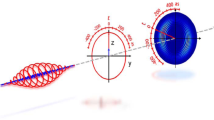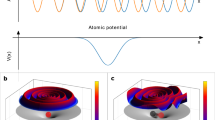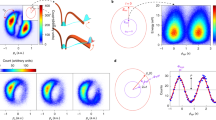Abstract
The tunnelling of a particle through a potential barrier is a key feature of quantum mechanics that goes to the core of wave–particle duality. The phenomenon has no counterpart in classical physics, and there are no well constructed dynamical observables that could be used to determine ‘tunnelling times’. The resulting debate1,2,3,4,5 about whether a tunnelling quantum particle spends a finite and measurable time under a potential barrier was reignited in recent years by the advent of ultrafast lasers and attosecond metrology6. Particularly important is the attosecond angular streaking (‘attoclock’) technique7, which can time the release of electrons in strong-field ionization with a precision of a few attoseconds. Initial measurements7,8,9,10 confirmed the prevailing view that tunnelling is instantaneous, but later studies11,12 involving multi-electron atoms—which cannot be accurately modelled, complicating interpretation of the ionization dynamics—claimed evidence for finite tunnelling times. By contrast, the simplicity of the hydrogen atom enables precise experimental measurements and calculations13,14,15 and makes it a convenient benchmark. Here we report attoclock and momentum-space imaging16 experiments on atomic hydrogen and compare these results with accurate simulations based on the three-dimensional time-dependent Schrödinger equation and our experimental laser pulse parameters. We find excellent agreement between measured and simulated data, confirming the conclusions of an earlier theoretical study17 of the attoclock technique in atomic hydrogen that presented a compelling argument for instantaneous tunnelling. In addition, we identify the Coulomb potential as the sole cause of the measured angle between the directions of electron emission and peak electric field: this angle had been attributed11,12 to finite tunnelling times. We put an upper limit of 1.8 attoseconds on any tunnelling delay, in agreement with recent theoretical findings18 and ruling out the interpretation of all commonly used ‘tunnelling times’19 as ‘time spent by an electron under the potential barrier’20.
This is a preview of subscription content, access via your institution
Access options
Access Nature and 54 other Nature Portfolio journals
Get Nature+, our best-value online-access subscription
$29.99 / 30 days
cancel any time
Subscribe to this journal
Receive 51 print issues and online access
$199.00 per year
only $3.90 per issue
Buy this article
- Purchase on Springer Link
- Instant access to full article PDF
Prices may be subject to local taxes which are calculated during checkout



Similar content being viewed by others
Data availability
The data that support the findings of this study are available from the corresponding authors on reasonable request.
Change history
01 May 2019
In this Letter, the statement ‘I.I. and A.B. performed computations at the NCI Australia’ was missing from the Acknowledgements section. This has been corrected online.
References
Wigner, E. P. Lower limit for the energy derivative of the scattering phase shift. Phys. Rev. 98, 145–147 (1955).
Smith, F. T. Lifetime matrix in collision theory. Phys. Rev. 118, 349–356 (1960).
Büttiker, M. & Landauer, R. Traversal time for tunneling. Phys. Rev. Lett. 49, 1739–1742 (1982).
Mandelstam, L. & Tamm, I. The uncertainty relation between energy and time in nonrelativistic quantum mechanics. J. Phys. 9, 249–254 (1945).
Yamada, N. Speakable and unspeakable in the tunneling time problem. Phys. Rev. Lett. 83, 3350–3353 (1999).
Hentschel, M. et al. Attosecond metrology. Nature 414, 509–513 (2001).
Eckle, P. et al. Attosecond angular streaking. Nat. Phys. 4, 565–570 (2008).
Eckle, P. et al. Attosecond ionization and tunneling delay time measurements in helium. Science 322, 1525–1529 (2008).
Pfeiffer, A. N. et al. Attoclock reveals natural coordinates of the laser-induced tunnelling current flow in atoms. Nat. Phys. 8, 76–80 (2012).
Pfeiffer, A. N., Cirelli, C., Smolarski, M. & Keller, U. Recent attoclock measurements of strong field ionization. Chem. Phys. 414, 84–91 (2013).
Camus, N. et al. Experimental evidence for quantum tunneling time. Phys. Rev. Lett. 119, 023201 (2017).
Landsman, A. S. et al. Ultrafast resolution of tunneling delay time. Optica 1, 343–349 (2014).
Kielpinski, D., Sang, R. & Litvinyuk, I. Benchmarking strong-field ionization with atomic hydrogen. J. Phys. At. Mol. Opt. Phys. 47, 204003 (2014).
Wallace, W. et al. Precise and accurate measurements of strong-field photoionization and a transferable laser intensity calibration standard. Phys. Rev. Lett. 117, 053001 (2016).
Khurmi, C. et al. Measuring laser carrier-envelope phase effects in the noble gases with an atomic hydrogen calibration standard. Phys. Rev. A 96, 013404 (2017).
Dörner, R. et al. Cold target recoil ion momentum spectroscopy: a ‘momentum microscope’ to view atomic collision dynamics. Phys. Rep. 330, 95–192 (2000).
Torlina, L. et al. Interpreting attoclock measurements of tunnelling times. Nat. Phys. 11, 503–508 (2015).
Ni, H., Saalmann, U. & Rost, J.-M. Tunneling ionization time resolved by backpropagation. Phys. Rev. Lett. 117, 023002 (2016).
Zimmermann, T., Mishra, S., Doran, B. R., Gordon, D. F. & Landsman, A. S. Tunneling time and weak measurement in strong field ionization. Phys. Rev. Lett. 116, 233603 (2016).
Ni, H., Saalmann, U. & Rost, J.-M. Tunneling exit characteristics from classical backpropagation of an ionized electron wave packet. Phys. Rev. A 97, 013426 (2018).
Corkum, P. B. Plasma perspective on strong field multiphoton ionization. Phys. Rev. Lett. 71, 1994–1997 (1993).
Kulander, K., Schafer, K. & Krause, J. in Super-Intense Laser–Atom Physics 95–110 (Plenum Press, New York, 1993).
Slevin, J. & Stirling, W. Radio frequency atomic hydrogen beam source. Rev. Sci. Instrum. 52, 1780–1782 (1981).
Pullen, M. G. Above Threshold Ionisation of Atomic Hydrogen Using Few-Cycle Pulses. Thesis, Griffith Univ. (2011).
Nurhuda, M. & Faisal, F. H. Numerical solution of time-dependent Schrödinger equation for multiphoton processes: a matrix iterative method. Phys. Rev. A 60, 3125–3133 (1999).
Douguet, N. et al. Photoelectron angular distributions in bichromatic atomic ionization induced by circularly polarized VUV femtosecond pulses. Phys. Rev. A 93, 033402 (2016).
Ivanov, I. Evolution of the transverse photoelectron-momentum distribution for atomic ionization driven by a laser pulse with varying ellipticity. Phys. Rev. A 90, 013418 (2014).
Bethe, H. A. & Salpeter, E. E. Quantum Mechanics of One-and Two-Electron Atoms (Springer, Berlin, 1957).
Sellin, I. Experiments on the production and extinction of the 2s state of the hydrogen atom. Phys. Rev. 136, A1245–A1253 (1964).
Acknowledgements
The experiments were performed at the Australian Attosecond Science Facility at Griffith University. We acknowledge the traditional custodians of the land on which this work was undertaken at Griffith University, the Yuggera people, and at ANU, the Ngunnawal people. U.S.S. and A.A.-T.-N. were supported by Griffith University International Postgraduate Research Scholarships (GUIPRS). H.X. was supported by an Australian Research Council Discovery Early Career Researcher Award (ARC DECRA: DE130101628). The work of N.D. and K.B. was supported by the United States National Science Foundation under grant no. PHY-1430245 and XSEDE allocation PHY-090031: their calculations were performed on SuperMIC at the Center for Computation and Technology at Louisiana State University. I.I. was supported by the Institute for Basic Science under grant number IBS-R012-D1. I.I. and A.B. performed their computations at the NCI Australia.
Author information
Authors and Affiliations
Contributions
U.S.S., X.W. and W.C.W. integrated the hydrogen source with REMI as part of the experimental set-up. U.S.S. with the assistance of H.X. and A.A.-T.-N. performed the experiments. U.S.S. and H.X. analysed the experimental data and post-processed theoretical data. Theoretical predictions were provided by A.B., A.K., I.I., N.D. and K.B. The project was conceived and supervised by R.T.S. and I.V.L. All authors discussed the results and contributed to the manuscript, with I.V.L. overseeing its preparation and revisions.
Corresponding authors
Ethics declarations
Competing interests
The authors declare no competing interests.
Additional information
Extended data
is available for this paper at https://doi.org/10.1038/s41586-019-1028-3.
Publisher’s note: Springer Nature remains neutral with regard to jurisdictional claims in published maps and institutional affiliations.
Extended data figures and tables
Extended Data Fig. 1 Experimental set-up.
As part of the atomic beamline, the water-cooled Pyrex discharge tube (connected by a gas line directly to the hydrogen cylinder) dissociates H2 to H. Any charged species leaving the tube are expelled by a uniform electric field before the beam enters the differential pumping stage through the first aperture (see inset). The beam then enters the REMI through a 0.5 mm aperture (second aperture; see inset) as a supersonic jet. The laser pulses pass through a series of pellicle beamsplitters (that vary intensity) and ultra-broadband waveplates (that introduce ellipticity) before interacting with H in the REMI. Ionized fragments are accelerated in uniform electric-magnetic fields and are finally detected on position sensitive detectors, helping to reconstruct the 3D-momentum distribution of the fragments. HWP, half-wave plate; QWP, quarter-wave plate; MCP, microchannel plates; hex-detector, hexagonal delay-line-anode detector.
Extended Data Fig. 2 Calibration of the reference frame.
The elliptically polarized few-cycle pulse is passed through a polarizer aligned vertically, and then made to interact with the atomic jet inside the REMI (a). The orientation of the field is found by determining the peaks of the PMD as a function of streaking angle (b), thereby giving us a systematic offset between the polarizer’s frame and REMI’s frame. The polarization is chosen parallel to the time-of-flight axis because of better momentum resolution in this direction. A systematic offset of about 3° was measured and used to calibrate our measured offsets and polarimetry. See Methods section ‘Analysis of data and results’ for details of this calibration procedure.
Extended Data Fig. 3 The Yukawa potential.
A short-range Yukawa potential was used to investigate the effects of the electric field of the resultant ion on the electron. The Yukawa potential (red line) is of the functional form UY = −(Z/r) × e−r/a, with parameters Z = 1.90831 and a = 1; r is distance from the nucleus. It goes to zero quickly in comparison to its Coulomb counterpart (blue line). The parameters were chosen to retain the ground-state energy of H.
Extended Data Fig. 4 Simulated momentum distributions for 1s and 2s states of H.
Simulations performed for a peak intensity of 1.9 × 1014 W cm−2 are shown for initial states 1s (left) and 2s (right). It is clear that the metastable H 2s is characterized by less energetic electrons with nearly uniform angular distribution. The colour represents the relative probability of an electron having a particular momentum—from zero (dark blue) to the highest (red).
Rights and permissions
About this article
Cite this article
Sainadh, U.S., Xu, H., Wang, X. et al. Attosecond angular streaking and tunnelling time in atomic hydrogen. Nature 568, 75–77 (2019). https://doi.org/10.1038/s41586-019-1028-3
Received:
Accepted:
Published:
Issue Date:
DOI: https://doi.org/10.1038/s41586-019-1028-3
This article is cited by
-
Tunnelling of electrons via the neighboring atom
Light: Science & Applications (2024)
-
Raman time-delay in attosecond transient absorption of strong-field created krypton vacancy
Nature Communications (2024)
-
Quantifying quantum coherence of multiple-charge states in tunable Josephson junctions
npj Quantum Information (2024)
-
Photon-statistics force in ultrafast electron dynamics
Nature Photonics (2023)
-
Coulomb and Quantum Interference Effects in the Spectra of High-Order Harmonics Generated by Aligned Molecules
Radiophysics and Quantum Electronics (2023)
Comments
By submitting a comment you agree to abide by our Terms and Community Guidelines. If you find something abusive or that does not comply with our terms or guidelines please flag it as inappropriate.



